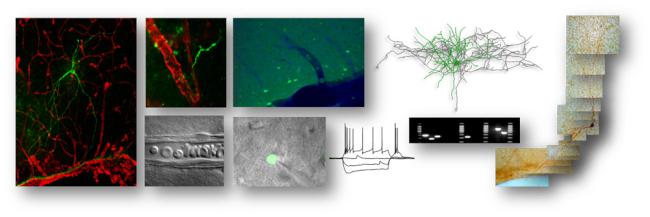Associate Professor of physiology, ESPCI ParisTech
Brain Plasticity Unit - CNRS UMR 8249
ESPCI ParisTech
10 rue Vauquelin
75231 Paris cedex 5 France
Tel: + 33 (0) 1 40 79 51 83
e-mail: ![]()

I am an Associate Professor in Neurophysiology, and my research is focused on the understanding of the neural mechanisms responsible for the alternation of sleep and wakefulness states. In 2002, I earned a Ph.D. in Neurophysiology from Université Claude Bernard in Lyon, focusing on the in vitro characterization of neurons located in the anterior hypothalamus, pivotal for inducing slow-wave sleep. My research led to the discovery that these neurons, alongside those in the waking systems, could inhibit each other, illustrating a reciprocal inhibitory interaction. In 2003, I joined Rossier’s laboratory at the Ecole Supérieure de Physique et de Chimie Industrielle (ESPCI) and Lambolez’ team at Sorbonne University in Paris as a postdoctoral fellows. Utilizing a combination of electrophysiological recordings with a single-cell RT-PCR multiplex technique, I uncovered cortical excitatory peptidergic pathways between GABAergic interneuron subtypes and glutamatergic pyramidal cells.
Upon being appointed as an Associate Professor in Physiology at the ESPCI in 2005, I played a pivotal role in identifying and characterizing the role of neocortical GABAergic interneurons in mice. Aligned with the work conducted during my Ph.D., I established, in 2011, a team named "Sleep Neuronal Networks" (SNN) within Brain Plasticity laboratory CNRS-UMR 8249. The team focused on understanding the cellular and molecular mechanisms responsible for initiating and maintaining slow-wave sleep. The SNN team received positive evaluations from the AERES committee and the CSI-ESPCI. Notably, we were the first to demonstrate in mice that glucose could excite sleep-promoting neurons in the hypothalamus, thereby facilitating sleep onset.
After leading the SNN team for several years, I made a strategic decision in 2017 to join the Emotional Memory Oscillations and Brain Body States (eMOBBS) team, led by Dr. K. Benchenane, in the Brain Plasticity laboratory. The team is dedicated to understanding the role of sleep on memory mechanisms and emotional states. My objective in joining the MOBS team was to complement the knowledge and tools necessary for developing new projects, particularly project focused on studying cortical control on the modulation of the activity of neural networks responsible for alternating wakefulness and sleep states. Currently, I employ both in vivo and ex vivo electrophysiology tools, coupled with optogenetic and chemogenetic approaches in free-moving mice, aiming to delve deeper into understanding the neural mechanisms driving the alternation of sleep-waking states.
– h-index: 23
Research profile
Neurophysiological roles of sleep promoting neurons in the VLPO
– in vitro electrophysiology (patch-clamp recordings),
– in vivo electrophysiology LFPS
– In vivo and in vitro Optogenetic
– Single cell multiplex RT-PCR,
– Immuno-histochemistry
– 3D Neuron reconstruction
Honors/Awards and Grants
– ANRJC "MetaboSleep" ANR-12-JSV4-0001-01 2013-2016 (PI: Dr. T. Gallopin)
– Fondation Pierre-Gilles de Gennes "FPGG030" 2012-2013 (PI: Dr. T. Gallopin)
– Fondation France Alzheimer, in collaboration with Dr. Claire Rampon 2009-2012 (PI: Dr. C. Rampon, Toulouse)
– PEPS CNRS « NEO-ID » in collaboration with Dr. Claire Rampon 2008 (PI: Dr. C. Rampon, Toulouse)
– Young researcher award (2003) of the « Société Française de Recherche sur le Sommeil »
– 3rd price from the « Société Suisse de Physiologie » (2000) (Switzerland)
Students
Current students
– Mathilde Chouvaeff, PhD Student Ed3c (2020-2023)
– Alice Descamps, PhD Student Ed3c (2023-2026)
Previous students
– Alice Descamps (M2 BIP, 2022-2023)
– Charles Hernoux, PhD student Ed3c (2018-2022)
– Mathilde Chouvaeff, (Master2 BIP, 2019-2020)
– Sophie Kolmayer, internship, year 3 of engineering ESPCI (2020)
– Alice Lallemand, internship, year 3 of engineering ESPCI (2020)
– Michella Khoury Damaa, internship, year 3 of engineering ESPCI (2019)
– Adele Ronciere, internship, year 3 of engineering ESPCI (2019)
– Apolline Fauchet, internship, year 3 of engineering ESPCI (2018)
– Julien Delaulne (Master2 BME, 2017-2018)
– Nastassia Pricoupenko, internship, year 3 of engineering ESPCI (2017)
– Marie Bourit Master student BIP (2016-2017)
– Léo Mace, Master student BIP (2015-2016)
– Quentin Perrenoud, PhD student FDV (2007-2011)
– Clémence Leclerc, PhD student ED3C (2009-2012)
– Elena Olive, Master BIP (2012-2013)
– Christophe Varin Master student (2010-2011)
– Benjamin Gautier, internship, year 3 of engineering ESPCI (2011)
– Rémi Deleurence, internship, year 3 of engineering ESPCI (2011)
– Cédric Faure, Master student (2009-2010)
– Christophe Varin, internship, year 3 of engineering ESPCI (2010)
– Thibault Toussaint, internship, year 3 of engineering ESPCI (2009)
– Axelle Schwob, internship, year 3 of engineering ESPCI (2009)
– Rémi Ducasse, internship, year 3 of engineering ESPCI (2008)
– Vincent Michel, internship, year 3 of engineering ESPCI (2005)
Publications
– Perrenoud Q, Leclerc C, Geoffroy H, Vitalis T, Richetin K, Rampon C, Gallopin T. Molecular and electrophysiological features of GABAergic neurons in the dentate gyrus reveal limited homology with cortical interneurons. PloS One . 2022 Jul 8;17(7):e0270981. doi: 10.1371/journal.pone.0270981. PMID: 35802727; PMCID: PMC9269967.
– Karagiannis A, Gallopin T, Lacroix A, Plaisier F, Piquet J, Geoffroy H, Hepp R, Naudé J, Le Gac B, Egger R, Lambolez B, Li D, Rossier J, Staiger JF, Imamura H, Seino S, Roeper J, Cauli B. Lactate is an energy substrate for rodent cortical neurons and enhances their firing activity. Elife . 2021 Nov
12;10:e71424. doi: 10.7554/eLife.71424.
– Tricoire L, Drobac E, Tsuzuki K, Gallopin T, Picaud S, Cauli B, Rossier J, Lambolez B. Bioluminescence calcium imaging of network dynamics and their cholinergic modulation in slices of cerebral cortex from male rats. J Neurosci Res . 2019 Jan 3. doi: 10.1002/jnr.24380.
– Sauvet F, Gomez-Merino D, Dorey R, Ciret S, Gallopin T, Drogou C, Arnal PJ, Chennaoui M. Lengthening of the photoperiod influences sleep characteristics before and during total sleep deprivation in rat. .J Sleep Res . 2018 Jun 4:e12709. doi: 10.1111/jsr.12709
– Chennaoui M, Arnal PJ, Dorey R, Sauvet F, Ciret S, Gallopin T, Leger D, Drogou C, Gomez-Merino D. Changes of Cerebral and/or Peripheral Adenosine A₁ Receptor and IGF-I Concentrations under Extended Sleep Duration in Rats. Int J Mol Sci . 2017 Nov 17;18(11). pii: E2439.
– Dispersyn G, Sauvet F, Gomez-Merino D, Ciret S, Drogou C, Leger D, Gallopin T, Chennaoui M. The homeostatic and circadian sleep recovery responses after total sleep deprivation in mice. J Sleep Res . 2017 Apr 20. doi: 10.1111/jsr.12541.
– Dubourget R, Sangare A, Geoffroy H, Gallopin T, Rancillac A. Multiparametric characterization of neuronal subpopulations in the ventrolateral preoptic nucleus. Brain Struct Funct. 2016 Jul 8. [Epub ahead of print]
– Sangare A, Dubourget R, Geoffroy H, Gallopin T, Rancillac A. Serotonin differentially modulates excitatory and inhibitory synaptic inputs to putative sleep-promoting neurons of the ventrolateral preoptic nucleus. Neuropharmacology . 2016 May 27;109:29-40.
– Scharbarg E, Daenens M, Lemaître F, Geoffroy H, Guille-Collignon M, Gallopin T, Rancillac A. Astrocyte-derived adenosine is central to the hypogenic effect of glucose. Scientific Report . 2016 Jan 12;6:19107.
– Chennaoui M, Gomez-Merino D, Drogou C, Geoffroy H, Dispersyn G, Langrume C, Ciret S, Gallopin T, Sauvet F. Effects of exercise on brain and peripheral inflammatory biomarkers induced by total sleep deprivation in rats. J Inflamm. 2015 Sep 30;12:56.
– Varin C, Rancillac A, Geoffroy H, Arthaud S, Fort P, Gallopin T. Glucose Induces Slow Wave Sleep by Exciting the Sleep-Promoting Neurons in the Ventrolateral Preoptic Nucleus: A New Link between Sleep and Metabolism. J Neurosci. 2015 Jul 8;35(27):9900-11. IF= 7,3 (5-Year)
– Richetin K, Leclerc C, Toni N, Gallopin T, Pech S, Roybon L, Rampon C. Genetic manipulation of adult-born hippocampal neurons rescues memory in a mouse model of Alzheimer’s disease. Brain . 2015 Feb;138(Pt 2):440-55. IF= 10,8 (5-Year)
– Rossier J, Bernard A, Cabungcal JH, Perrenoud Q, Savoye A, Gallopin T, Hawrylycz M, Cuénod M, Do K, Urban A, Lein ES. Cortical fast-spiking parvalbumin interneurons enwrapped in the perineuronal net express the metallopeptidases Adamts8, Adamts15 and Neprilysin. Mol Psychiatry . 2014 Dec 16. [Epub ahead of print]. IF= 14,1 (5-Year)
– Pohlkamp T, Dávid C, Cauli B, Gallopin T, Bouché E, Pichler M, Leemhuis J, Karagiannis A, May P, Herz J, Frotscher M, Staiger JF, Bock HH. Characterization and Distribution of Reelin-Positive Interneuron Subtypes in the Rat Barrel Cortex Cerebral Cortex . 2013, in press. IF= 8,3 (5-Year)
– Battaglia D, Karagiannis T, Gallopin T, Gutch HW, Cauli B. Beyond the frontiers of neuronal types. Frontiers in neural circuits . 2013, in press. IF= 3,8 (5-Year)
– Perrenoud Q, Rossier J, Férézou I, Geoffroy H, Gallopin T, Vitalis T, Rancillac A. Activation of cortical 5-HT(3) receptor-expressing interneurons induces NO mediated vasodilatations and NPY mediated vasoconstrictions. Front Neural Circuits . 2012;6:50. IF= 3,8 (5-Year)
– Perrenoud Q, Geoffroy H, Gautier B, Rancillac A, Alfonsi F, Tekki-Kessaris N, Rossier J, Vitalis T, Gallopin T. Characterisation of type I and type II nNOS-expressing interneurons in the barrel cortex of mouse. Frontiers in neural circuits . 2012, in press. IF= 3,8 (5-Year)
– Perrenoud Q, Rossier J, Geoffroy H, Vitalis T, Gallopin T. Diversity of GABAergic interneurons in layer VIa and VIb of mouse barrel cortex. Cerebral Cortex . 2013, Feb;23(2):423-41. IF= 8,3 (5-Year)
– Hu E, Demmou L, Cauli B, Gallopin T, Geoffroy H, Harris-Warrick RM, Paupardin Tritsch D, Lambolez B, Vincent P, Hepp R. VIP, CRF, and PACAP Act at Distinct Receptors to Elicit Different cAMP/PKA Dynamics in the Neocortex. Cerebral Cortex . 2011, 21(3):708-18. IF= 8,3 (5-Year)
– Vucurovic K*, Gallopin T*, Ferezou I*, Rancillac A, Chameau P, van Hooft JA, Geoffroy H, Monyer H, Rossier J, Vitalis T. Serotonin 3A Receptor Subtype as an Early and Protracted Marker of Cortical Interneuron Subpopulations. Cerebral Cortex . 2010, 20(10):2333-47. IF= 8,3 (5-Year) *contributed equally to this work.
– Karagiannis A*, Gallopin T*, Dávid C*, Battaglia D*, Geoffroy H, Rossier J, Hillman EM, Staiger JF, Cauli B. Classification of NPY-expressing neocortical interneurons. Journal of Neuroscience . 2009. 29(11):3642-59. IF= 7,3 (5-Year) *contributed equally to this work.
– Andjelic S, Gallopin T, Cauli B, Hill EL, Roux L, Badr S, Hu E, Tamás G, Lambolez B. Glutamatergic nonpyramidal neurons from neocortical layer VI and their comparison with pyramidal and spiny stellate neurons. Journal of Neurophysiology . 2009. 101(2):641-54. IF= 3.4 (5-Year)
– Hill EL, Gallopin T, Férézou I, Cauli B, Rossier J, Schweitzer P, Lambolez B. Functional CB1 receptors are broadly expressed in neocortical GABAergic and glutamatergic neurons. Journal of Neurophysiology . 2007. 97(4):2580-9. IF= 3.4 (5-Year)
– Gallopin T, Geoffroy H, Rossier J, Lambolez B. Cortical sources of CRF, NKB, and CCK and their effects on pyramidal cells in the neocortex. Cerebral Cortex . 2006. 16(10):1440-52. IF= 8,3 (5-Year)
– Gallopin T, Luppi PH, Cauli B, Urade Y, Rossier J, Hayaishi O, Lambolez B, Fort P. The endogenous somnogen adenosine excites a subset of sleep-promoting neurons via A2A receptors in the ventrolateral preoptic nucleus. Neuroscience . 2005. 134(4):1377-90. IF=3.45 (5-Year)
– Gallopin T, Luppi PH, Rambert FA, Frydman A, Fort P. Effect of the wake-promoting agent modafinil on sleep-promoting neurons from the ventrolateral preoptic nucleus: an in vitro pharmacologic study. Sleep. 2004. 27(1):19-25. IF= 6,2 (5-Year)
– Gallopin T*, Fort P*, Eggermann E*, Cauli B, Luppi PH, Rossier J, Audinat E, Mühlethaler M, Serafin M. Identification of sleep-promoting neurons in vitro. Nature . 2000. 404(6781):992-5. IF= 40,7 (5-Year) *contributed equally to this work
Book chapter
Fort P., Luppi P.H., and Gallopin T. 2004 In vitro identification of the presumed sleep-promoting neurons of the ventrolateral preoptic nucleus (VLPO).
Other
Gallopin T. 2004 Comment s’endort-on ? La Recherche. N°371.



